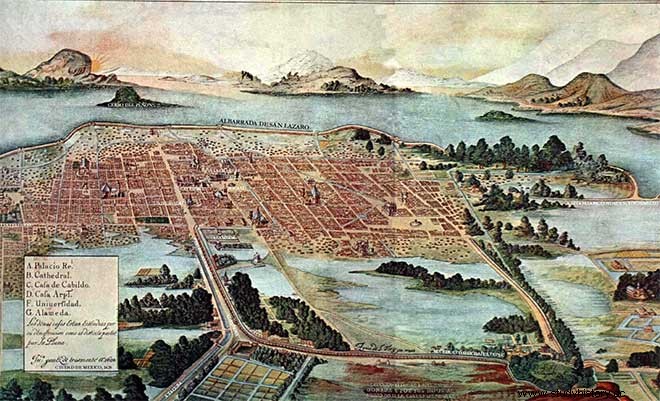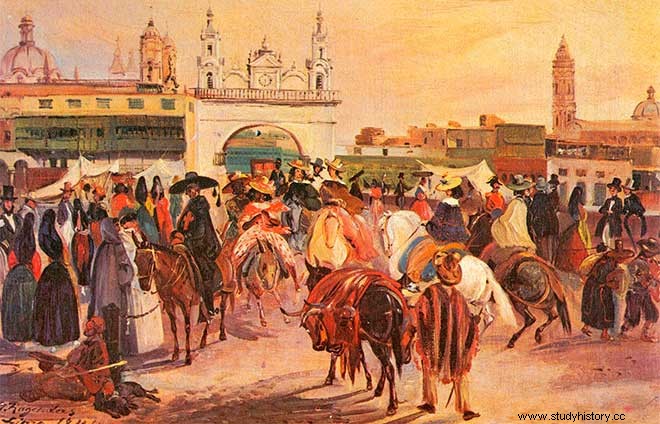In the mid-seventeenth century, the administrative organization of the American territories owed much to the contribution of the capital cities (Mexico and Lima) of the two viceroyalties (New Spain and Peru), which were capable of housing educational centers, of disseminating ideas, to promote culture in all its spheres and to surround himself, in short, with an authentic Court in Hispanic America far from the metropolis. The urban framework of the capital-cities of the viceroyalties was capable of organizing and interweaving a whole network of small cities and towns that produced its effect in a true cultural integration. Undoubtedly, among the essential aspects that promoted the introduction of the entire Hispanic culture are:on the one hand, the spread of Spanish, on the other, the role of the printing press and, finally, the foundation of the University . All these elements are clearly related and owe their reason for being to the impulse promoted by the first two viceroyalty cities founded in Hispanic America:the cities of Mexico and Lima.
Mexico City
Mexico City, refounded by Hernán Cortés in 1521 on the foundations of the last Aztec capital, Tenochtitlán, underwent an extraordinary urban transformation throughout the 17th century. The first steps were taken during the viceroyalty of don Antonio de Mendoza , in the 1530s. The constant floods produced during the 16th century and the beginning of the 17th century forced a profound reflection on the need to build strong dams and even to proceed with a drainage canal to empty the lagoon. Expansion projects for an expanding city would no longer stop, as evidenced by deforestation for lumber, intensive farming systems, which would end up eroding the soil, and modifications to the dike system, with changes hydraulics that would propitiate. Around 1650, according to the chroniclers, the city exceeded 20,000 buildings and towards the end of the century it could house some 50,000 souls (1689). The city continued to transform itself and as the chronicles point out, there is hardly a street where houses are not built or decorated . In some way, the way is being prepared for the great changes that will take place in the capital city during the Bucarelli viceroyalty in the 18th century with the Bourbon reforms. The role of the viceregal administration was fundamentally reinforced in the sections of hygiene, health and police, which demanded through sanctions and ordinances a regulation of urban activities in the center of the capital and in the neighborhoods. A growth that is manifested, above all, in the quality of the buildings and in the urban expansion that will take the city to exceed 150,000 inhabitants.

Lime
As regards the city of the Kings of Lima, named in honor of the epiphany, it was founded in 1535 by Francisco Pizarro . The dense network of indigenous settlements, sufficiently articulated, had prevented the founding of cities in Peru on a larger scale. The city is the capital of the Viceroyalty of Peru, seat of the Court (1542) and Archbishop's seat, by privilege granted by the Holy See (1546), it has a Court of the Inquisition, a University and an important cathedral.
The frequent earthquakes (four between 1586 and 1687) forced to deploy an important constructive activity. Aqueducts, breakwaters or retaining walls appear before the flooding of the rivers, the bridge over the Rimac is finished, the cathedral is built (completed in 1622), new hospitals are built (San Lázaro, La Caridad, San Juan de Dios, San Pedro and the Holy Spirit), numerous convents and monasteries are erected. In other words, the city is articulated around its neighborhoods and by 1630 there are already 30,000 inhabitants. The port function of Lima from Callao, allowed it a first-rate oceanic projection, leaving from its docks different discovery expeditions, such as that of Mendaña, to discover the Salomón or those of Fernández de Quirós and Báez de Torres to discover, as indicated some historiographic current, Australia , in homage to the Habsburg dynasty ruling in Spain. The capital of the viceroyalty also concentrates significant amounts of funds that come from the mining districts, fundamentally from the potosí hill mines .
As the capital-city of the viceroyalty and university headquarters, Lima was a participant in multiple cultural expressions. From the University of San Marcos , as the disseminating head of culture, to the most modest colleges and schools of the city, a whole cultural environment was generated to which the gatherings in the residences of some nobles contributed. Members of the nobility, artists and scientists attended the academies, societies and salon gatherings, who together with writers, poets and playwrights allow us to assess the intellectual level of the city. The bibliographical production, thanks to the pull of the printing press, from its beginnings in 1584, throws clarifying data on the cultural magnitude of Lima and the viceroyalty.
The capital expands and its constructions pave the way for the enlightened projects of the 18th century, such as the Paseo de las Aguas, the bullring and the Alameda de Lima, all of them achievements of the building policy of Viceroy Amat. Due to its political position, its economic activity and its socio-cultural projection, with an intense intellectual life, Lima played a leading role in the New World until the middle of the 18th century. Although the creation of the viceroyalty of New Granada (1717) reorganized the political demarcations, Lima lost only some territories that actually already enjoyed their autonomy. Without a doubt, the greatest impact occurred with the creation of the viceroyalty of La Plata (1776), which changed the course and orientations imposed by the new mercantile traffic.

Mexico and Lima became, until the appearance of the new system modeled by the Bourbons and the configuration of two new viceroyalties in the 18th century, in the capital cities that united power and makers of cultural integration. They housed the first universities, the first cathedrals, the first educational centers, the first printing presses and mint stores, in short, the necessary instruments for political, social, religious and cultural governance. The Viceroyalty Courts, appearing in the shadow of these cities, would only corroborate the important power exercised by the viceroys, always mediated by the influence of the Creole elites, and sometimes too far outside the instructions sent from Madrid.
